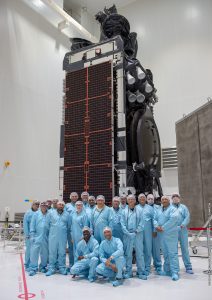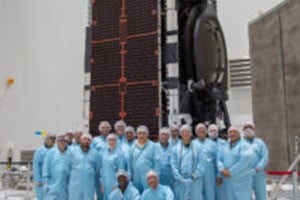Intelsat Epic: First Global Ku-Band HTS Platform Provides Government Customers with Unprecedented Performance, Resiliency, Reliability and Efficiency

Government customers require reliable and resilient satcom wherever missions take them. With the successful launch of Horizons 3e, the Intelsat Epic global high-throughput satellite (HTS) constellation is now complete. For the U.S. military and NATO allies this means that they will have immediate access to a high performing, resilient and redundant network for mobility missions at sea, on land and in the air – whenever or wherever they need it.
The sixth and final of the first-generation Intelsat Epic satellites, Horizons 3e, brings the most advanced digital payload, C- and Ku- band interconnectivity and optimized power sharing technology to the Asia Pacific and Pacific Ocean regions.
One of the advanced features on Horizons 3e is the multiport amplifier which optimizes power across the satellite. With the multiport amplifier, if one spot beam is idle, its allocated power can be distributed to other beams to meet customer throughput demands. By matching satellite power usage to traffic demands, government customers can leverage the additional efficiency improvements to expand their network and applications across the Asia and Pacific Ocean regions. In addition to the power sharing technology, Horizons 3e provides additional resiliency to the IntelsatOne® Flex managed service platform, allowing the DoD to purchase an end-to-end mobility solution.
The Intelsat Epic HTS constellation far surpasses the bandwidth speed and throughput possible with previous, wide-beam satellites. Tests conducted earlier this year on a Gilat 6” flat panel antenna on Intelsat 29e demonstrated throughput rates of 3.9 Mbps with an efficiency of 0.26 bits/Hz. This compares to an uplink rate of 1.8 Mbps and an efficiency of 0.09 bits/Hz achieved with a conventional wide-beam satellite. The HTS link was effectively twice the data rate and almost 3x more efficient than traditional wide-beam satellites.
This superior performance powers new applications and services for government users. For example, the Marine Corps uses Intelsat Epic HTS to support their Networking-on-the-Move (NOTM) requirements. Operating over Intelsat 29e, Marine users are able to achieve a total simultaneous throughput of approximately 4.0 Mbps between 20cm terminals, as measured in one test, substantially more than with previous solutions. And U.S. Special Operations Command (SOCOM) can now support high-definition full-motion video (HD-FMV) over small, Class III unmanned aircraft systems (UAS), something never before possible.
The global Intelsat Epic network also uses an open architecture, an important distinction for HTS. Closed systems dictate to the end users which terminals and teleport locations must be used. They also require new investments in proprietary modem technologies and service architectures. Being forced to use the provider’s infrastructure also limits the DoDs flexibility in using its own C2 network. For these and other reasons, most government satcom networks cannot easily migrate to a closed architecture.
Intelsat Epic supports a wide range of communication topologies and allows the U.S. military to leverage the Ku-band antenna and modem infrastructure already in place across the DoD, including communications-on-the-move (COTM), airborne, and UAS. This ability to use current ground equipment leads to substantial cost savings for the government customer.
There is accelerating demand for HTS satcom in Asia, driven by increasing use of unmanned UAS for border security and peace-keeping operations. Governments in the Asia Pacific region are increasing UAS deployments at a time when advances in sensor technologies require higher throughput satellites to transfer the high-resolution imagery resulting from these sensors. HTS is ideally suited for these types of applications.
The introduction of new HTS technology has created next generation architectures in space. Intelsat General is dedicated to working with its government customers through this transformation, collaborating on the new business and procurement models needed to take full advantage of commercial innovation in space.
Horizons 3e is undergoing in-orbit testing and is expected to become operational in the first quarter of 2019.






















